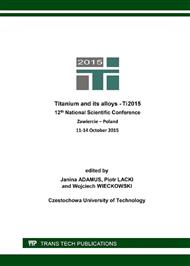[1]
P. Lacki, J. Adamus, W. Więckowski, J. Winowiecka, Evaluation of drawability of titanium welded sheets, Archives of Metallurgy and Materials 58 (2013) 139–143.
DOI: 10.2478/v10172-012-0164-7
Google Scholar
[2]
J. Winowiecka, W. Więckowski, M. Zawadzki, Evaluation of drawability of tailor-welded blanks made of titanium alloys grade 2 || grade 5, Computational Materials Science 77 (2013) 108–113.
DOI: 10.1016/j.commatsci.2013.04.026
Google Scholar
[3]
J. Winowiecka, W. Więckowski, P. Lacki, J. Adamus, Numerical and experimantal analysis of forming titanium welded blanks, Rudy i Metale Nieżelazne 59 (2014) 173–181.
Google Scholar
[4]
J. Winowiecka, The analysis of springback of titanium sheet after bending, Obróbka Plastyczna Metali XXIV (2013) 219–231.
Google Scholar
[5]
P. Lacki And J. Adamus, Possibility Of The Increase In Titanium Sheets' Drawability, Key Eng. Mat. 549 (2013) 31–38.
DOI: 10.4028/www.scientific.net/kem.549.31
Google Scholar
[6]
M. Motyka, J. Sieniawski, W. Ziaja, Microstructural aspects of superplasticity in Ti-6Al-4V alloy, Materials Science and Engineering A 599 57–63.
DOI: 10.1016/j.msea.2014.01.067
Google Scholar
[7]
J. Adamus, P. Lacki, Investigation of sheet-titanium forming with flexible tool – experiment and simulation, Key Eng. Mat. 549 (2013) 31–38.
Google Scholar
[8]
J. Adamus, P. Lacki, Analysis of forming titanium welded blanks, Comp. Mater. Sci. (2014).
Google Scholar
[9]
S.P. Keeler, W.A. Backofen, Plastic instability and fracture in sheets stretched over rigid punches, Trans. ASM 56 (1963).
Google Scholar
[10]
G.M. Goodwin, Application of strain analysis to sheet metal forming problems in the press shop, Metall Italiana 60 (1698) 764–774.
Google Scholar
[11]
A. Rezaee-Bazzaz, H. Noori, R. Mahmudi, Calculation of forming limit diagrams using Hill's 1993 yield criterion, International Journal of Mechanical Sciences 53 (2011) 262–270.
DOI: 10.1016/j.ijmecsci.2011.01.007
Google Scholar
[12]
S. Ahmadi, A.R. Eivani, A. Akbarzadeh, An experimental and theoretical study on the prediction of forming limit diagrams using new BBC yield criteria and M–K analysis, Comp. Mater. Sci. 44 (2009) 1272–1280.
DOI: 10.1016/j.commatsci.2008.08.013
Google Scholar
[13]
M. Abspoel, M. E. Scholting, J. M. M. Droog, A new method for predicting Forming Limit Curves from mechanical properties, J. Mater. Process. Tech. 213 (2013) 759–769.
DOI: 10.1016/j.jmatprotec.2012.11.022
Google Scholar
[14]
M. Merklein, A. Kuppert, M. Geiger, Time dependent determination of forming limit diagrams, CIRP Annals - Manufacturing Technology 59 (2010) 295–298.
DOI: 10.1016/j.cirp.2010.03.001
Google Scholar
[15]
(GOM mbH, ARAMIS v6. 3 and higher - User Manual, 2011).
Google Scholar
[16]
(GOM mbH, ARAMIS, ARGUS, SVIEW - FLC Computation v6. 1. 1 and higher, 2009).
Google Scholar
[17]
F. Djavanroodi, A. Derogar, Experimental and numerical evaluation of forming limit diagram for Ti-6Al-4V titanium and Al6061-T6 aluminum alloys sheets, Mater. Design 31 (2010) 4866–4875.
DOI: 10.1016/j.matdes.2010.05.030
Google Scholar
[18]
P. Lacki, J. Adamus, W. Więckowski, J. Winowiecka, Modelling of stamping process of titanium tailor-welded blanks, Computer Methods in Materials Science 13 (2012) 339–344.
Google Scholar
[19]
A.S. Atal, M.T. Shete, Formability analysis of deep drawing process by finite element simulation, International Journal of Science and Research 6 (2014) 2153–2156.
Google Scholar
[20]
K.S. Oh, K.H. Oh, J.H. Jang, D.J. Kim, K.S. Han, Design and analysis of new test method for evaluation of sheet metal formability, J. Mater. Process. Tech. 211 (2011) 695–707.
DOI: 10.1016/j.jmatprotec.2010.12.004
Google Scholar
[21]
Q. Situ, M. K. Jain, D. R. Metzger, Determination of forming limit diagrams of sheet materials with a hybrid experimental–numerical approach, Int. J. Mech. Sci. 53 (2011) 707–719.
DOI: 10.1016/j.ijmecsci.2011.06.003
Google Scholar
[22]
J. Adamus, K. Dyja, M. Motyka, Experimental and theoretical determination of forming limit curve, Arch. Metall. Mater. 60/3 (2015) 1881-1885.
DOI: 10.1515/amm-2015-0321
Google Scholar


